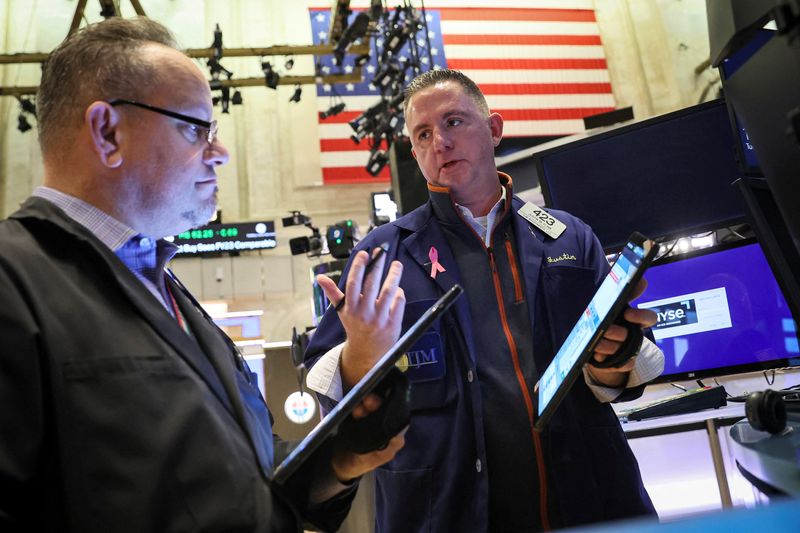 © Reuters. FILE PHOTO: Traders work on the floor of the New York Stock Exchange (NYSE) in New York City, U.S., November 22, 2022. REUTERS/Brendan McDermid
© Reuters. FILE PHOTO: Traders work on the floor of the New York Stock Exchange (NYSE) in New York City, U.S., November 22, 2022. REUTERS/Brendan McDermid
By Caroline Valetkevitch
NEW YORK (Reuters) - U.S. stocks will end next year up around 6% after a rough start to 2023 as higher interest rates take their toll on the U.S. economy, according to a Reuters poll of strategists on Tuesday.
Among the biggest risks to the market are that the U.S. Federal Reserve pushes the economy into recession as it hikes rates to fight rampant inflation and that corporate U.S. earnings growth turns flat, the strategists said.
The benchmark S&P 500 index will end next year at 4,200, according to the median forecast of 41 strategists polled by Reuters during the last two weeks. That is 6.0% higher than Monday's close of 3,963.94.
That median forecast for year-end 2023 is down from a target of 4,700 in a Reuters poll conducted in late August.
"It's a tale of two halves. We see the market as having a rougher start to the year and closing the year in recovery mode," Savita Subramanian, head of U.S. equity and quantitative strategy at BofA Securities, said at the firm's outlook conference Monday.
The firm sees the S&P 500 ending next year at 4,000, and it expects a mild recession in the first half of 2023 and an easing of Fed policy by the end of next year.
Wall Street stocks have rallied strongly in recent weeks, partly on hopes the Fed will be less aggressive in its rate increases. The Fed earlier in November delivered a fourth consecutive 75-basis-point interest rate hike.
Rate policy will hinge on the path of inflation in coming months, among other factors. U.S. consumer prices rose less than expected in October, pushing the annual increase below 8% for the first time in eight months.
But the S&P 500 remains down almost 17% for the year to date after falling into its second bear market since the 2020 global sell-off caused by the coronavirus pandemic.
Professional strategists have mostly had poor track records predicting stock market returns, especially at the start of a new year because so much remains unknown, yet their forecasts provide valuable insight into sentiment on Wall Street.
Most strategists polled expected the earnings picture to get worse over the next six months rather than to improve, with some projecting no earnings growth for the S&P 500 in 2023.
"At present, company guidance for 2023 is largely elusive given economic uncertainty, ongoing inflationary pressures and lack of visibility into consumer and business spending in 2023," said Terry Sandven, chief equity strategist at U.S. Bank Wealth Management in Minneapolis, Minnesota. Sandven sees the S&P 500 ending 2023 at 4,275.
Analysts are projecting fourth-quarter U.S. earnings will decline for the first time in two years, based on IBES data from Refinitiv, and estimates have been falling for 2023 as well.
They are forecasting full-year profit growth for 2023 at 4.9% compared with estimated growth of 5.8% for all of 2022, based on the data.
Earnings estimates are closely watched because of their impact on stock valuations. The S&P 500's forward 12-month price-to-earnings ratio is now at about 18 compared with 22 at the end of December 2021 and a long-term average of about 16, according to Refinitiv data.
"There's still uncertainty about earnings, whether that's going to stabilize or not. But towards the middle of the year is when rates may start to come down," said King Lip, chief strategist at BakerAvenue Wealth Management in San Francisco. He sees the S&P 500 ending next year at 4,400.
For sectors, BofA's Subramanian thinks energy, which is up 61% for the year so far and is the best-performing S&P 500 sector, has more room to run. She is underweight technology, among other sectors. Lip recommends industrials but would avoid energy.
Based on the poll, the Dow Jones industrial average will finish the year at 36,500, up 7.8% from Monday's close.
(Other stories from the Reuters Q4 global stock markets poll package:)

